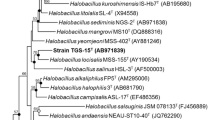Abstract
The isolation of obligate halophilic aspergilli from the Dead Sea and the range of salt tolerance of halophilic fungi isolated, are reported here for the first time. The mycobiota of the Dead Sea isolated in this study, was dominated by Aspergillus and Penicillium species; Cladosporium were found in lesser numbers. All three genera were obtained from the water sample; however, Aspergillus was the only genus obtained from the sediment. There was significant difference in growth of each isolate at different salt concentrations and intraspecies analysis revealed dissimilarity in response of strains to different salt concentrations in the growth medium The isolates were euryhaline, with halotolerance up to 20–25% solar salt, Aspergillus and Penicillium species showing a higher level of halotolerance, as compared to that of Cladosporium. Halophilic fungi were found in greater numbers in the sediment sample as compared to that in the water sample. Penicillium and Cladosporium species were exclusively facultative halophiles, while some species of Aspergillus were facultative halophiles. All the obligate halophiles isolated, belonged to the genus Aspergillus and were identified as A. penicillioides and A unguis, the latter being a first record of the species from the Dead Sea.


Similar content being viewed by others
References
DasSarma S, Arora P (2002) Halophiles. In: Encyclopedia of life sciences, vol 8. Nature Publishing Group, London, pp 458–466
Das S, Lyla PS, Khan SA (2006) Marine microbial diversity and ecology: importance and future perspectives. Curr Sci 90:1325–1335
Grishkan I, Nevo E, Wasser SP (2003) Soil micromycete diversity in the hypersaline Dead Sea coastal area, Israel. Mycol Prog 2:19–28
Gunde-Cimerman N, Plemenitas A (2006) Ecology and molecular adaptation of the halophilic black yeast Hortaea werneckii. Rev Environ Sci Biotechnol 5:323–331
Buchalo AS, Nevo E, Wasser SP, Oren A, Molitoris HP (1998) Fungal life in the extremely hypersaline water of the Dead Sea: first records. Proc R Soc Lond 265:1461–1465
Kis-Papo T, Oren A, Wasser SP, Nevo E (2003) Survival of filamentous fungi in hypersaline Dead Sea water. Microbial Ecol 45:183–190
Grant WD (2004) Life at low water activity. Phil Trans R Soc Lond B 359:1249–1267
Kushner DJ (1978) Life in high salt and solute concentrations. In: Kushner DJ (ed) Microbial life in extreme environments. Academic Press, London, pp 317–368
Domsch KH, Gams W, Anderson TH (1980) Compendium of soil fungi, vol 1. IHW-Verlag, Eching
Ellis MB (1971) Dematiaceous hyphomycetes. Commonwealth Mycological Institute, Kew, Surrey, England
Raper KB, Fennell DI (1965) The genus Aspergillus. Williams and Wilkins Co, Baltimore
Oren A (2003) Physical and chemical limnology of the Dead Sea. In: Nevo E, Oren A, Wasser SP (eds) Fungal life in the Dead Sea. Gantner Verlag, Ruggel, pp 45–67
Kunte JH, Truper HG, Stan-Lotter S (2002) Halophilic microorganisms. In: Horneck G, Baumstark C (eds) Astrobiology: the quest for the conditions of life. Springer, Berlin, pp 185–199
Steiman R, Ford L, Ducros V, Lafond JL, Guiraud P (2004) First survey of fungi in hypersaline soil and water of Mono Lake area (California). Antonie van Leeuwenhoek 85:69–83
Gunde-Cimerman N, Cerovac S, Zalar P (2001) Biodiversity of filamentous fungi in the saltpans Secovlje. Acta Biol Slov 44:25–30
Gunde-Cimerman N, Lorena B, Sonjak S, Turk M, Uršič V, Zalar P, Plemenitaš A (2005) Halotolerant and halophilic fungi from coastal environments in the Arctics. In: Gunde-Cimerman N, Oren A, Plemenitaš A (eds) Adaptation to life at high salt concentrations in Archaea bacteria and Eukarya. Springer, The Netherlands, pp 397–423
Cantrell SA, Casillas-Martinez L, Molina M (2006) Characterization of fungi from hypersaline environments of solar salterns using morphological and molecular techniques. Mycol Res 110:962–970
Kis-Papo T, Grishkan I, Gunde-Cimerman N, Oren A, Wasser SP, Nevo E (2003) Spatiotemporal patterns of filamentous fungi in the hypersaline Dead Sea. In: Nevo E, Oren A, Wasser SP (eds) Fungal life in the Dead Sea. Gantner Verlag, Ruggel, pp 271–292
Wasser SP, Grishkan I, Kis-Papo T, Buchalo AS, Paul AV, Gunde-Cimerman N, Zalar P, Nevo E (2003) Species diversity of the Dead Sea fungi. In: Nevo E, Oren A, Wasser SP (eds) Fungal life in the Dead Sea. Gantner Verlag, Ruggel, pp 203–270
Ravishankar JP, Suryanarayanan TS, Muruganandam (2006) Strategies for osmoregulation in the marine fungus Cirrenalia pygmea Khol. (Hyhomycetes). Indian J Mar Sci 34:351–358
Redkar RJ, Lemke PA, Singh NK (1996) Altered gene expression in Aspergillus nidulans in response to salt stress. Mycologia 88:256–263
Author information
Authors and Affiliations
Corresponding author
Rights and permissions
About this article
Cite this article
Nazareth, S., Gonsalves, V. & Nayak, S. A First Record of Obligate Halophilic Aspergilli from the Dead Sea. Indian J Microbiol 52, 22–27 (2012). https://doi.org/10.1007/s12088-011-0225-z
Received:
Accepted:
Published:
Issue Date:
DOI: https://doi.org/10.1007/s12088-011-0225-z




